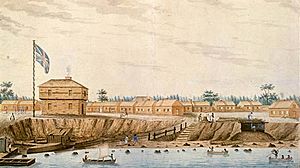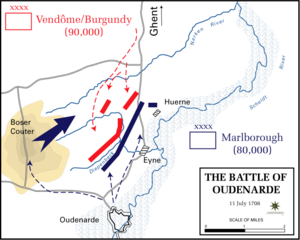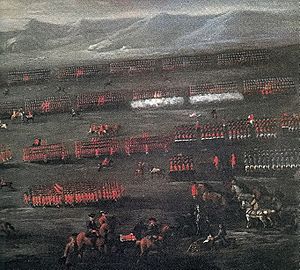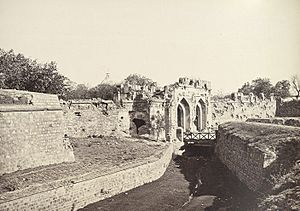8th (The King's) Regiment of Foot facts for kids
Quick facts for kids 8th (King's) Regiment of Foot |
|
|---|---|

Cap badge of the 8th (The King's) Regiment of Foot
|
|
| Active | 19 June 1685 – 1 July 1881 |
| Country |
|
| Branch | Army |
| Type | Line Infantry |
| Size | Two battalions |
| Regimental Depot | Peninsula Barracks, Warrington |
| Nickname(s) | The Leather Hats, The King's Hanoverian White Horse |
| Motto(s) | Nec Aspera Terrent (Difficulties be Damned) |
| Colours | Blue |
| March | Here's to the Girl |
| Anniversaries | Blenheim (13 August) Delhi (14 September) |
| Battle honours | Blenheim, Ramillies, Oudenarde, Malplaquet, Dettingen, Martinique 1809, Niagara, Delhi 1857, Lucknow, Peiwar Kotal |
| Commanders | |
| Colonel of the Regiment |
General Thomas Gerrard Ball (1861–1881) |
The 8th (King's) Regiment of Foot was a famous infantry regiment in the British Army. It was created in 1685. Later, in 1881, it changed its name to the King's (Liverpool Regiment).
As a "line infantry" regiment, the 8th (King's) often served overseas. They were stationed in places like British North America, India, and the British West Indies. These trips could last a very long time, sometimes more than ten years. For example, their first time in North America lasted from 1768 to 1785.
The regiment fought in many important wars. These included conflicts with France, the American Revolution, the War of 1812, and the Indian rebellion of 1857. Because of army changes, the 8th Regiment became the King's (Liverpool Regiment). It already had ties to Liverpool because its main base moved there in 1873.
History of the King's Regiment
The regiment first formed in 1685. It was called the Princess Anne of Denmark's Regiment of Foot. This happened during a rebellion led by the Duke of Monmouth against King James II. After King James II lost his throne in the "Glorious Revolution", the regiment's leader, the Duke of Berwick, left to join the King in exile. A new leader, Colonel John Beaumont, took over.
The regiment fought in Ireland during the Siege of Carrickfergus in 1689. The next year, they were at the Battle of the Boyne. They also took part in sieges at Limerick, Cork, and Kinsale under the command of John Churchill.
Fighting in the War of the Spanish Succession (1701–1714)
For nearly ten years, the regiment was based in England, Ireland, and the Dutch Republic. In 1702, Princess Anne became Queen. The regiment was then renamed the Queen's Regiment of Foot. However, people still often called it "Webb's Regiment" after its colonel, John Richmond Webb.
The War of the Spanish Succession started over who would be the next king of Spain. The Queen's Regiment fought in the Low Countries in 1702. They helped protect the Dutch army during a retreat near Nijmegen. Soon after, Marlborough took command of the Allied army. The regiment helped capture several towns like Venlo, Roermond, and Liège.
In 1704, Marlborough decided to move his army into Bavaria to fight the French. This was a secret plan. On July 2, the army attacked and captured the Schellenberg. On August 13, the Allies met the French and Bavarian army at the Battle of Blenheim. The Queen's Regiment, led by Lieutenant-Colonel Richard Sutton, helped capture hundreds of French soldiers. The battle was a huge victory for the Allies.
After Blenheim, the Queen's Regiment returned to action in 1705. They helped capture Huy and attacked the Lines of Brabant. In May 1706, the French attacked again in the Low Countries. Marlborough's army met them at the Battle of Ramillies on May 23. The Queen's Regiment played a key role in this battle, which ended in a complete defeat for the French. After this, the Allies captured many towns like Antwerp and Brussels. The regiment's last siege of 1706 was at Menin, a very strong fortress.
In 1708, the Queen's Regiment was called back to Britain because of a threat of a Jacobite uprising in Scotland. After the danger passed, they returned to the Low Countries. On July 11, Marlborough led the Allied army against the French at the Battle of Oudenarde. The Queen's Regiment was part of the first group to cross the Scheldt river. They quickly defeated a group of Swiss soldiers. The regiment then fought hard near the village of Herlegem until it got dark.
The Queen's Regiment then took part in several sieges, including Ghent and Lillie. In 1709, they helped in the long Siege of Tournai. On September 11, the regiment fought in the very bloody Battle of Malplaquet. They were sent in late in the battle and advanced under heavy fire. A soldier from the regiment, Private Matthew Bishop, wrote that the French "soon broke us in a terrible manner," but they kept fighting.
In 1710, the regiment was involved in the sieges of Douai, Béthune, and Aire.
Jacobite Rebellions and New Conflicts (1715–1768)
In 1715, a rebellion started in Britain. Supporters of James Stuart, called the "Old Pretender", wanted to put him on the throne instead of King George I. The Queen's Regiment went to Scotland to join the Government army. On November 13, the Battle of Sheriffmuir began.
The Queen's Regiment was on the left side of the army. They faced a fast charge from the Highlanders. The fighting was hand-to-hand, and the regiment's side eventually broke and retreated. The Queen's had many soldiers killed, wounded, or captured. In 1716, King George I honored the regiment for its service at Sheriffmuir. The Queen's became the King's Regiment of Foot, and its badge became the White Horse of Hanover.
The King's Regiment stayed in Scotland until 1717, when the rebellion ended. They also served in Ireland for several years. In 1742, they went to Flanders to fight in the War of the Austrian Succession. They fought at the Battle of Dettingen in June 1743, where Britain and its allies defeated a larger French army. The regiment also fought at the Battle of Fontenoy in May 1745.
In 1745, Bonnie Prince Charlie landed in Scotland, trying to restore the Stuart family to the throne. The regiment fought at the Battle of Falkirk Muir in January 1746. They were on the front line and had to retreat when the Highlanders charged. The regiment also fought in the Battle of Culloden in April 1746. Here, they provided important cross-fire support against the charging Highlanders. The regiment had only one soldier badly wounded in this battle.
The King's Regiment also fought in the Battle of Rocoux in October 1746 and the Battle of Lauffeld in July 1747. In 1751, the British Army gave numbers to its regiments. The King's became the 8th (King's) Regiment of Foot. The Seven Years' War began, and the 8th Regiment grew to two battalions. Its second battalion later became the 63rd Regiment of Foot in 1758.
In 1760, the 8th King's Regiment joined the Hanoverian Army. Its grenadier company fought in the battles of Warburg and Kloster Kampen. The full regiment fought at Kirch-Denkern, Wilhelmsthal, and helped capture Cassel.
The American Revolutionary War (1775–1783)
The 8th Foot arrived in Canada in 1768. Its ten companies were spread out to guard forts on the Great Lakes. These included Fort Niagara, Fort Detroit, and Fort Michilimackinac. As their time there was ending, protests in the American colonies grew stronger. These protests were about self-rule and "taxation without representation". They soon turned into a rebellion against Britain in 1775.
Some officers in the 8th Foot were very good at working with Native American tribes. Captain Arent DePeyster and Lieutenant John Caldwell were two of them. Caldwell was said to have married a member of the Ojibwa tribe and became a chief. Captain DePeyster helped keep peace between the British and tribes like the Mohawk and Ojibwa. In 1778, he arranged for over 550 warriors from different tribes to help the British.
The American invasion of Canada began in mid-1775. By late November, Americans had captured several forts and were attacking Quebec City. British reinforcements arrived in May 1776 and pushed the Americans out. After this, a small group from the 8th Foot fought its first major battle of the war.
Captain George Forster of the 8th Foot led a force of British soldiers and Native American warriors. They crossed the St. Lawrence River to attack Fort Cedars, held by Americans. On May 18, Forster asked the American commander to surrender. The Americans, scared by Native American war chants, agreed the next day. An American relief force was ambushed by Forster's men. The Native American allies were angry because one of their chiefs was killed. Forster paid them to prevent harm to the prisoners.
Later, the British withdrew from Pointe-Claire after seeing the strength of General Benedict Arnold's forces. Arnold pursued them, but Forster stopped him by placing men and captured cannons along the river. On May 27, a prisoner exchange was agreed upon.
In July 1777, the regiment sent 100 men to the Siege of Fort Stanwix. This force ambushed American troops at the Battle of Oriskany in August 1777. However, the siege failed a few weeks later when their Native American allies left.
The regiment also fought in other actions. These included Vincennes and the Battle of Newtown in 1779. They also saw action in the Mohawk Valley in 1780 and Kentucky in 1782. Captain Henry Bird of the 8th Regiment led a siege of Fort Laurens in 1779. In 1780, he led an invasion of Kentucky, capturing two fortified settlements and 300 prisoners. The regiment returned to England in September 1785.
French Revolutionary and Napoleonic Wars (1793–1815)
In 1793, France declared war on Great Britain. The King's Regiment was sent to the Netherlands. In 1794, they tried to break the French Siege of Nijmegen. They launched a surprise night attack and fought hand-to-hand. Despite their success, Nijmegen was soon evacuated, and the British left the Netherlands in 1795.
In 1799, the King's Regiment was stationed on Menorca, an island captured from Spain. In 1801, the regiment landed in Egypt to fight a French invasion. They helped capture Rosetta and a fort in Romani. By September, the British had taken control of Egypt.
War of 1812 in North America
The 1st Battalion of the regiment moved to Canada in 1808. In January 1809, they went to Martinique to invade the island. Many soldiers died from disease during this time. The 8th Foot returned to Nova Scotia in April. When tensions between the United States and Britain led to the War of 1812, the 1st and 2nd battalions were in Quebec and Nova Scotia.

In February 1813, Lieutenant-Colonel George MacDonnell of the 8th Foot led an attack on Ogdensburg in New York State. The 8th Foot and Canadian militia crossed the frozen St. Lawrence River. They captured the fort after close-quarters fighting. The British destroyed buildings and ships, then left with supplies and prisoners. Ogdensburg was not rebuilt as a fort, which brought peace to the area.
In April 1813, two companies of the 8th Regiment tried to stop an American attack on York (now Toronto). The grenadier company fought the Americans with bayonets, losing many men. The Americans took the area but suffered many casualties when the British blew up Fort York's main gunpowder storage.
While guarding Fort George in May 1813, the 8th Foot tried to stop an American landing. Though outnumbered, they slowed the invasion and retreated in good order. In June 1813, the 8th and 49th regiments attacked an American camp at Stoney Creek. Five companies fought over 4,000 Americans in a night battle. The British commander decided to withdraw, even though they had captured two American generals.
In July 1814, the regiment fought in the Battle of Chippawa. Later that month, they fought in the Battle of Lundy's Lane. This was one of the bloodiest battles in Canadian history. The next month, the King's Regiment took part in the action at Snake Hill during the siege of Fort Erie. In September 1814, the Americans attacked with a huge force, and the regiment suffered heavy losses. The King's Regiment earned the battle honor 'Niagara' for its role in the war. The regiment returned to England in summer 1815.
Indian Rebellion and Afghan War (1857–1881)
Between 1815 and the Indian rebellion of 1857, the King's Regiment served in many places. These included Bermuda, Canada, Gibraltar, and Ireland. In 1846, the regiment began a 14-year stay in India. In May 1857, when the rebellion began, the 8th Foot was in Jullundur.
The rebellion started due to many reasons. A main trigger in 1857 was a rumor that animal fat was used to grease rifle cartridges. This upset both Hindu and Muslim soldiers. The rebellion spread, and the 8th Regiment's commander sent two companies to secure the fort of Phillaur. This fort had important supplies.
After seven weeks in Jullundur, the regiment joined an army preparing to attack Delhi. There were not enough troops, so it took weeks to gather enough strength.
In July 1857, two companies helped defend a position that had been under attack for seven hours. The King's Regiment helped capture Ludlow Castle near the Kashmir Gate in Delhi. On September 14, the 8th King's attacked Delhi. They aimed to capture the Water Bastion and Kashmiri Gate. After the British secured the city, the 8th Regiment's Lieutenant-Colonel Edward Greathed became commander of a force sent to Cawnpore. The regiment was much smaller now. The regiment also helped in the second Relief of Lucknow in November. They saw a lot of fighting before leaving on November 22.
The 1st Battalion returned to Britain in 1860. In 1865, it was in Dublin, Ireland, helping with operations against Irish Republican activity. After two years in Malta, the 1st King's returned to India in 1868. The regiment's 2nd Battalion, formed in 1857, also served in Malta and India.
In November 1878, Britain invaded Afghanistan. This started the Second Anglo-Afghan War. The 2nd King's Regiment was sent to the Kurram Valley Field Force. The 2nd King's fought at the Battle of Peiwar Kotal in November 1878.
The regiment was not greatly changed by the army reforms of the 1870s and 1880s. It already had two battalions, so it didn't need to merge with another regiment. On July 1, 1881, the regiment was renamed the King's Regiment (Liverpool).
Colonels of the Regiment
These are the main commanders of the regiment over time:
Princess Anne of Denmark's Regiment of Foot
- 1685–1687: Col Robert Shirley, Lord Ferrers of Chartley
- 1687–1688: Lt-Gen James FitzJames, 1st Duke of Berwick
- 1688–1695: Col John Beaumont
- 1695–1715: Lt-Gen John Richmond Webb
Queen's Regiment of Foot
- 1715–1720: Brig-Gen Henry Morrison
King's Regiment of Foot
- 1720–1721: Sir Charles Hotham, 4th Baronet
- 1721–1732: Brig-Gen. John Pocock
- 1732–1738: Col. Charles Lenoe
- 1738–1745: Lt-Gen. Richard Onslow
- 1745–1759: Lt-Gen. Edward Wolfe
8th (The King's) Regiment
- 1759–1764: Major-Gen. The Hon. John Barrington
- 1764–1766: Lt-Gen. John Stanwix
- 1766–1772: Lt-Gen. Daniel Webb
- 1772–1794: Gen. Bigoe Armstrong
- 1794–1814: Gen. Ralph Dundas
- 1814–1825: Gen. Edmund Stevens
- 1825–1846: Gen. Henry Bayly, GCH
- 1846–1854: Gen. Sir Gordon Drummond, GCB
- 1854–1855: Lt-Gen. John Duffy, CB, KC
- 1855–1860: Gen. Roderick Macneil
- 1860–1861: Maj-Gen. Eaton Monins
- 1861–1881: Gen. Thomas Gerrard Ball
For colonels after 1881 see King's Regiment (Liverpool)






